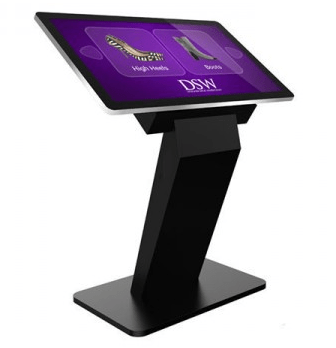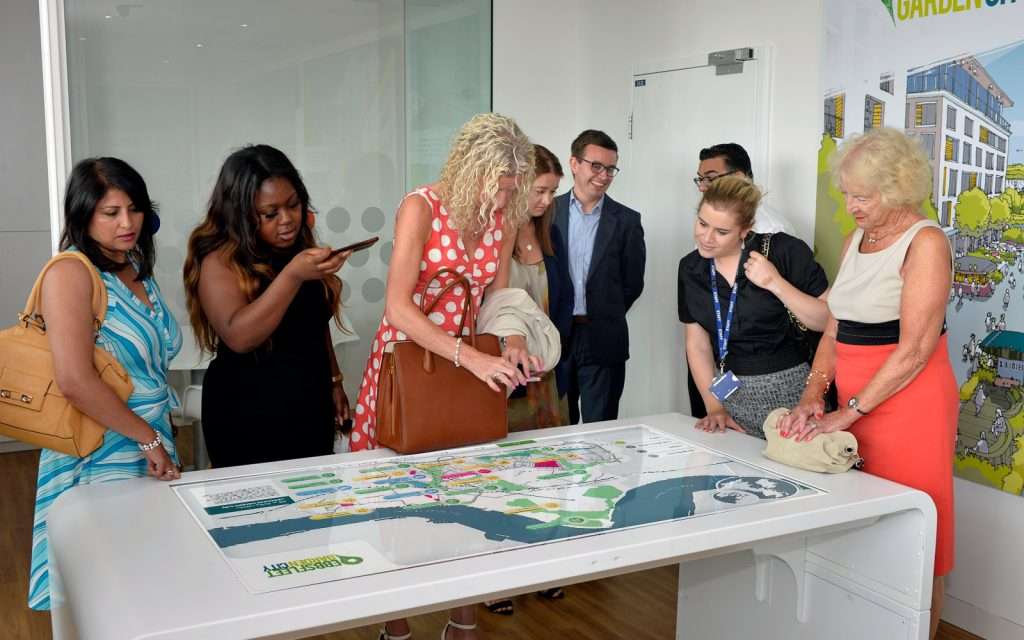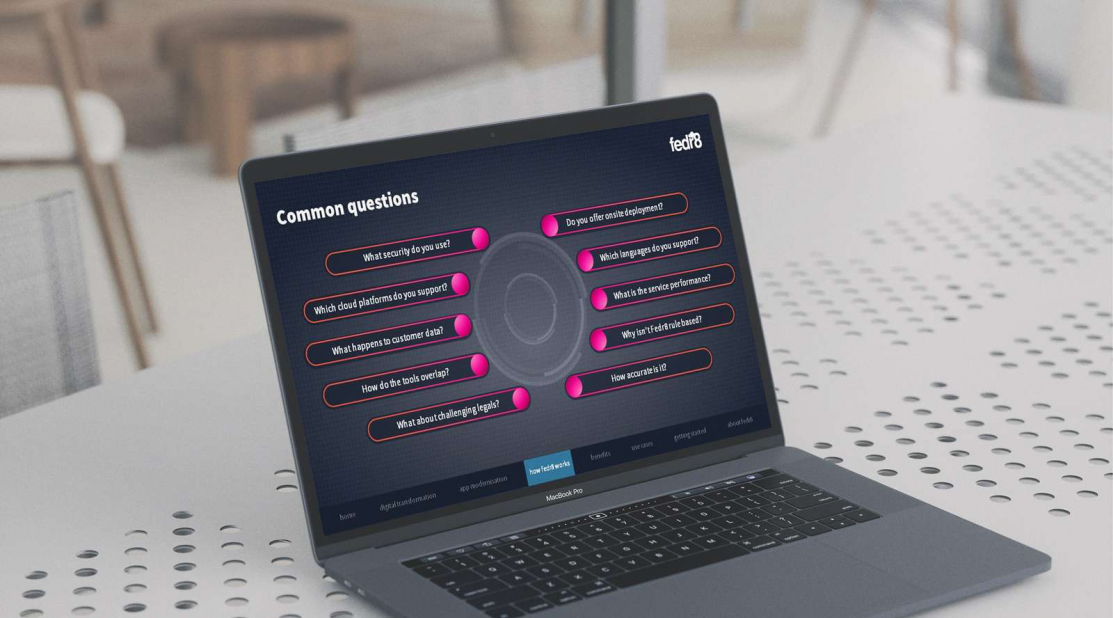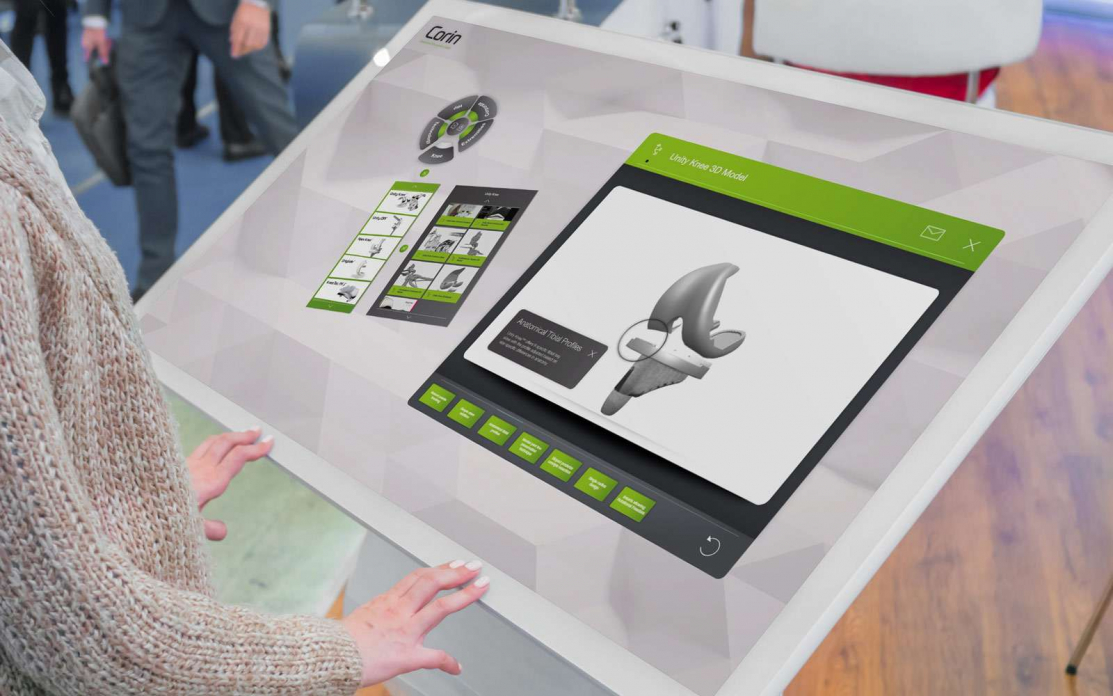Are you looking to develop an interactive touchscreen experience to showcase your business at an event, exhibition or tradeshow? Or perhaps you want an interactive sales tool on a touchscreen in a demo area, showroom, customer centre or marketing suite to help demonstrate your products and ultimately improve sales?
Then in this blog we’ll take you through the costs and the many different options that are available for all budgets. We’ll also introduce you to how we can help you every step of the way.
What is a touchscreen experience?
Before we go any further, let’s first outline what is needed for a touchscreen experience.
Firstly, there is the physical touchscreen which people touch and interact with and then you also need a PC to run the software that displays the visual experience on the screen.
The second part is the visual experience, so what you see and interact with on screen and this experience needs to be run by software and there are different applications that do this.
Thirdly, that same visual experience needs to be created in the first place and again there are different software applications (here’s a blog we’ve written on the software used to create touchscreen experiences) out there to develop touchscreen experiences.
A good analogy is your PC and monitor at work that you browse the internet with. The monitor would be the touchscreen, the PC has all the software that displays on the monitor and the webpage is the visual experience you interact with. Then that webpage has been created either by being coded in HTML or a special application has been used to create it.
How much does it cost to make a touchscreen?
So, you’re hoping to develop a touchscreen experience for an event or an exhibition, or perhaps you’d like an interactive experience for a customer sales suite? But you’re unsure how much it will cost. Broadly speaking a touchscreen experience can be broken down into the three parts mentioned above and each has an associated cost.
There will be a huge difference in cost depending on factors that we’ll highlight below. It won’t cover everything, but we’ll be able to give you a reasonable idea of your investment. One other factor to consider is whether you get an agency to create the touchscreen experience for you or if you develop it internally, this will have a big impact on your costs.
What are your hardware options?
For the screens there are several different types:
- Wall-mounted
- Freestanding
- Touch tables
- Handheld (basically tablets)
Which option is best for you will depend upon where you are going to be using your experience and who will be using it.
Tip: Take a look at five of the best hardware options for interactive display solutions.
Different screen technologies
There are also different types of screen to be aware of when considering how much it costs to make a touchscreen.
Resolution is important, you can get standard HD screens, 4k screens and even 8k screens (I’m not going to talk about these as they are too expensive). The price difference between HD and 4K isn’t huge and we’d always recommend going for a higher quality screen if possible, so 4K all the way. Practically what it means is that text and images will be sharper on a 4k screen making them easier to read and clearer.
The other difference is in the way the screen recognises touch and there are two main types here. Infra-Red and PCAP (projective capacitive screen). iPads and most tablets use PCAP, it’s more sensitive and accurate and has a completely flat glass screen so looks really nice.
Infra-Red is an older technology, the only benefit to it is that you can wear gloves to use the screen or use any object to interact with it as it doesn’t rely on your finger touching the screen. You also get a bezel with these screens, e.g., a raised outer edge so they don’t look as sleek. Where possible we always recommend PCAP.

Wall mounted
Wall-mounted screens are good if you have limited space but they have to be fixed into place and can get tiring for users if your experience takes time to explore, imagine holding your arm up for 5 minutes! You also have to be careful of the size you go for as people have to be able to touch all parts of the screen. If it’s too high people won’t be able to reach the top of the screen. For disabled people who might be in wheelchairs, these will be almost impossible to use.

People are also tempted to want really big screens e.g., 90 inches, be careful, a screen this size is almost impossible to use as the top of the screen will be beyond most peoples’ reach and in order to see the whole screen, you’d have to step back meaning you can no longer touch the content.

- 32” PCAP £700
- 43” PCAP £1200
- 55” PCAP 4K £1900
- 55” Infra-Red £1200
Freestanding screens
Freestanding screens are great as they are more comfortable to use, you have an element of privacy as people can’t really see what you are tapping and can be easily moved. They are much better for disabled access as well.
These touchscreens are usually made of three parts:
1. The screen
2. The stand
3. The PC – although in some cases the screens come with built-in PCs, more about this further on

You can get a range of different stand types to suit the environment and some come with powered adjustable heights. You can then buy a screen separately (a wall-mounted screen above) best sizes are usually 32”-55”.
The above example of a touch screen will cost approx. £2,700
It’s important to consider the type of stand because if it is being used in a public space like a retail setting it needs to be sufficiently heavy so that it can’t easily be knocked over.
Stands on their own for use with larger screens e.g, from 32”-55” will cost approx. £700
Touch tables
Touch tables are impressive and movable if you have space (they are very heavy) but are great if it’s a shared experience as multiple people can use them at the same time.

There are a lot of different styles and prices vary depending on size from approx. £6,500-£12,000

Computers
It’s much simpler to work out what type of computer you will need. Basically, it comes down to how much processing power you need and this is dependent on how much you’ve got going on in your experience.
You have to use a PC as Macs don’t support touch interactions. Whether you chose a desktop, laptop or mini PC will depend on where it will sit in relation to the screen. Space is usually tight, so a mini PC is a good option, they are significantly smaller than desktops and laptops and just as powerful. We always specify an i7 8th Gen CPU, min 16gig Ram, 250gig Solid State Drive and a decent graphics card.
Some touchscreens come with built in mini PCs but these will be low spec and only able to run quite simple experiences. If you have video and 3D models or complex graphics, then an inbuilt PC won’t work. Our advice is always go for the most powerful PC you can afford. Intel NUCs are one of our favourites.
They range in price from £700-£1,200 depending on how powerful it is.

What software options are available?
Now we come to the most important part; the visual experience itself. This is the heart of any interactive and affects the way users engage with your content and the experience they have.
This is where touch screen costs will vary wildly. If you are looking for an agency to build an experience for you the starting cost could easily by £15k, our experiences usually start at around this amount. The top end could easily be tens of thousands. It really depends on the complexity of the experience, the content you include in your touchscreen experience e.g, 3D models, complex animations and integration with other systems.
The application used to develop the experience will also have an impact as some are quicker to use than others. We develop our touchscreen experiences either as progressive web apps or use specialist software such as Intuiface or Ventuz .
If you were going to develop the touchscreen experience yourself then you’d have to factor the cost of the software into your budget. A progressive web app doesn’t have any software cost as the tools are open source, however, Intuiface and Ventuz are expensive. Needless to say, you would need specialist inhouse skills to create the experience. Applications like Intuiface are fairly quick to learn and a good designer would be able to pick it up quite quickly.
Tip: Take a look at our recent blog for more information about the advantages and restrictions of different software options.
The development process
It is possible to develop a Touchscreen experience inhouse. However, if you are looking to invest a large amount of money in the hardware it makes sense to use a specialist agency to consult and develop the experience. They know the questions to ask, have encountered all the highs and lows of development and will support you after the project is delivered.
The main steps any good agency should go through with a customer when developing an experience are: Establish the business objectives for the experience
- Map out the user journey and customer experience
- Design the overall look and feel with customer branding
- Advise on hardware and software requirements
- Develop the experience in the appropriate application or language
- Undertake any integrations with other customer systems e.g, CRM, CMS or DAMs
- Help with the installation and deployment of the experiences
- Provide ongoing support and analytics on usage
What should be included in the typical touch screen cost?
If you’re getting a quote from a supplier to provide the equipment then it should include everything from the touchscreens and computers, to the mount, full installation, set-up and ongoing support and warranties.
In terms of software, design and development, we include everything to deliver and support an experience so that the customer doesn’t have to think of everything or worry about any hidden costs at all.
Next steps…
If you’re going to get an external company put a touchscreen experience in place think carefully about what you need and who you will approach.
One of the big mistakes we see companies do all the time is going to a hardware supplier for a quote first as there are plenty out there and they assume that the supplier will also create the experience.
This usually isn’t the case.
Hardware suppliers will rarely create the content for you and in our experience you should be cautious if they offer to as it is likely they won’t specialise or have much experience developing experiences that will meet your customers’ expectations.
You get what you pay for, and cutting corners may result in a lesser experience, which your audience may find difficult to use. If they walk away, you’ve wasted your time and money.
In our opinion always start with the experience itself, the bit that your customers or audience interact with as that is the most complex part, the hardware is the easy bit.
Getting the most out of your touch screen cost
At POPcomms we work with clients to develop touchscreen experiences that deliver on their business objectives and work for their customers and audience to create memorable experiences.
We’re always happy to just have a chat, discuss a potential project or idea without any hard sell. Simply get in touch today on +44 (0)117 329 1712 or hello@popcomms.com. Or if you’d like to keep updated on projects we’re working on subscribe to our newsletter or follow us on LinkedIn.

Related Posts

What Are the Options for Creating Persuasive Presentations?
Read

Creating an Interactive Touchscreen Experience: Where to Start
Read

Why Advanced Manufacturers Should Use Touchscreens at Events and in Innovation Centres
Read

Bringing Scotland’s Moving Image Archive to Life Through an Interactive Touchscreen Experience
Read